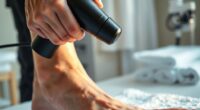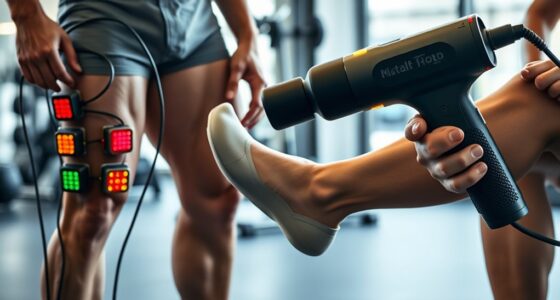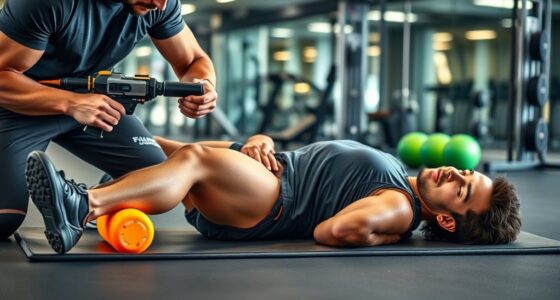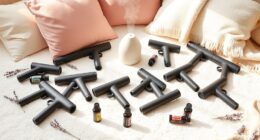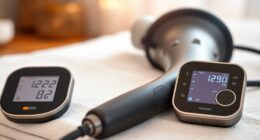To boost your recovery, incorporate foam rolling to release muscle tightness and improve blood flow, focusing on major groups like calves and quads. Use a massage gun to target knots and muscle soreness, enhancing circulation and relaxing muscles after runs. Finish with stretching—dynamic before runs to warm up, static afterward to improve flexibility and prevent injuries. Sticking to these practices can markedly speed up your recovery, and more tips await if you continue exploring.
Key Takeaways
- Incorporate foam rolling post-run to release muscle adhesions and improve blood flow to major muscle groups.
- Use massage guns to target knots, increase circulation, and activate muscles for quicker recovery.
- Combine dynamic stretching before runs to warm muscles, and static stretching afterward to enhance flexibility and reduce soreness.
- Regularly spend 1-2 minutes on each muscle group to maximize recovery benefits from foam rolling and massage therapy.
- Integrate these methods into a comprehensive routine to prevent injuries and maintain optimal running performance.
The Benefits of Foam Rolling and How to Use It Effectively
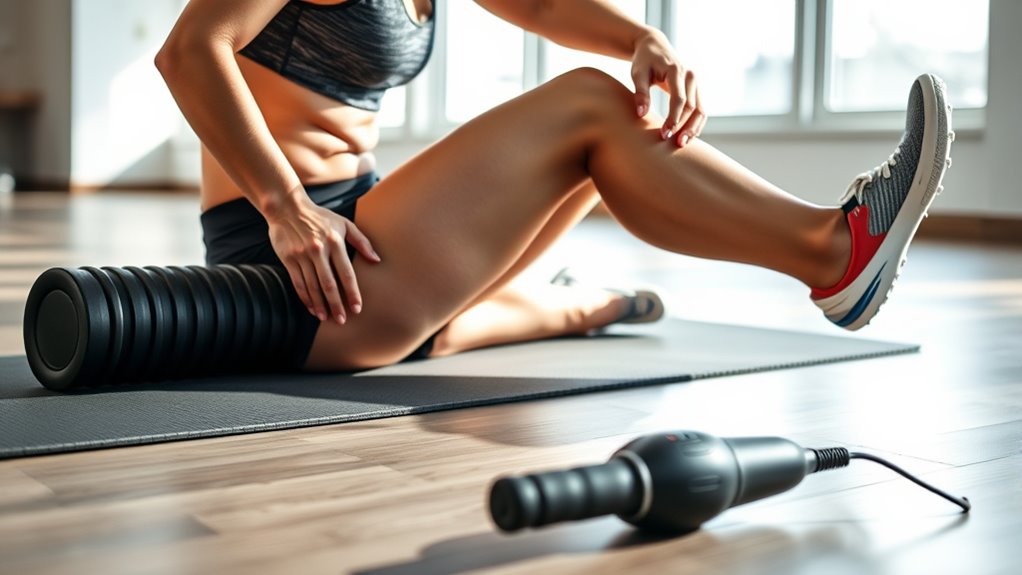
Foam rolling is a popular recovery technique that can help reduce muscle tightness and improve flexibility. When you use a foam roller, you’re engaging in muscle release, which helps break up adhesions and increase blood flow. This process alleviates soreness and prepares your muscles for future runs. To use it effectively, target major muscle groups like your calves, quads, and hamstrings, applying gentle pressure and rolling slowly. Avoid rolling directly over joints or bony areas to prevent discomfort. Consistency is key—spend about 1-2 minutes on each muscle group after runs or workouts. Proper technique ensures you get the most benefit from foam rolling, making it a essential part of your recovery routine. Additionally, understanding the role of contrast ratio can help you choose the right projector settings for viewing your favorite movies or sports during recovery downtime.
Massage Guns: Targeted Relief for Post-Run Recovery
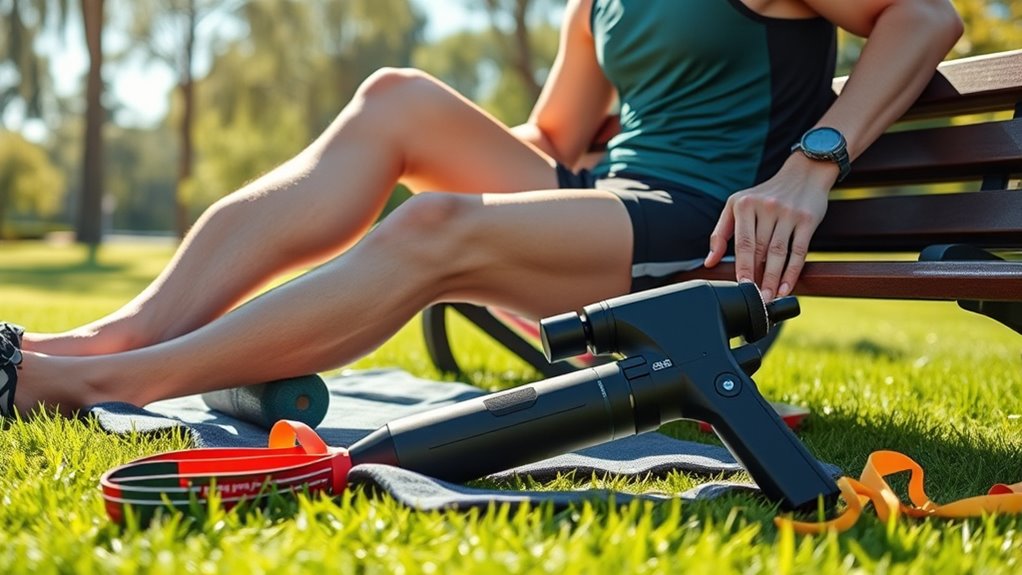
Massage guns have become a go-to tool for runners seeking quick, targeted relief after a workout. They provide deep tissue therapy by breaking up muscle knots and increasing blood flow, which aids recovery. Using a massage gun helps activate muscles, preparing them for your next run while reducing soreness. You can tailor the intensity and attachment for specific muscle groups, ensuring effective relief where you need it most. Incorporate massage guns into your routine post-run to enhance muscle recovery and prevent tightness. Understanding the importance of proper muscle care can further optimize your recovery routine.
Stretching Techniques to Enhance Flexibility and Prevent Injuries
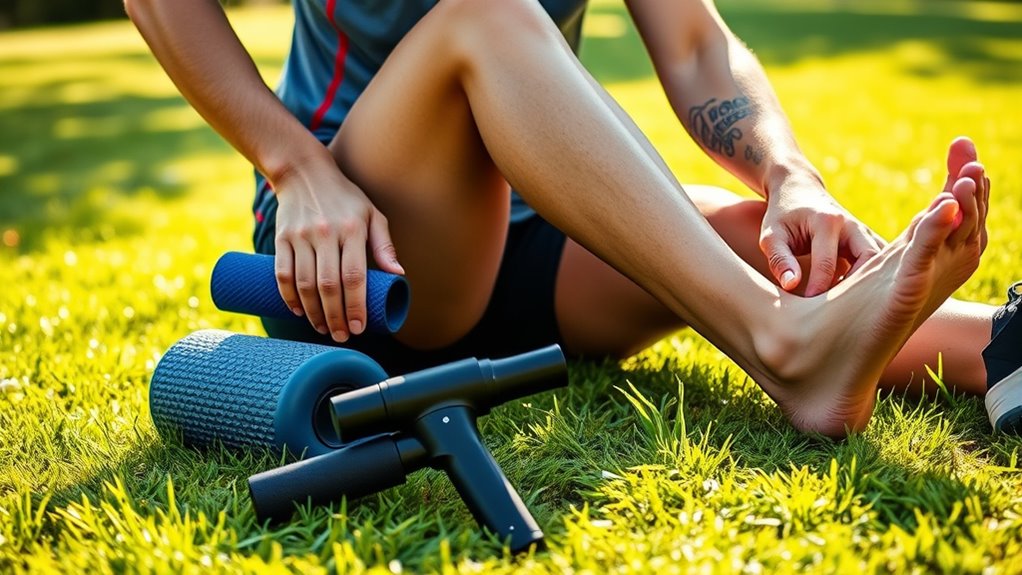
To prevent injuries and improve your running performance, incorporating effective stretching techniques into your routine is essential. Start with dynamic stretching before your run to warm up your muscles and increase blood flow. Movements like leg swings, high knees, and lunges prepare your body for activity and improve flexibility. After your run, focus on static stretching to relax muscles and enhance flexibility. Hold each stretch for at least 20 seconds, targeting areas like hamstrings, calves, and hip flexors. This helps prevent tightness and reduces injury risk. Incorporating aquatic exercise can also support recovery and flexibility by reducing impact stress on joints. Combining dynamic stretching before running and static stretching afterward creates a balanced approach to flexibility. Consistently using these techniques ensures your muscles stay limber, supporting peak performance and long-term injury prevention.
Frequently Asked Questions
How Often Should Runners Incorporate Foam Rolling Into Their Routine?
You should incorporate foam rolling into your recovery routine based on your recovery frequency and how your body feels. Aim for a foam rolling schedule of 3-4 times per week, especially after intense runs or workouts. Consistency helps prevent tightness and soreness. Listen to your body—if you notice increased flexibility and less soreness, you’re on the right track. Adjust your foam rolling routine as needed for maximum recovery.
Are Massage Guns Safe for All Types of Injuries?
They say, “Prevention is better than cure,” and that’s true when considering massage gun safety. Not all injury types respond well to massage guns; for certain injuries like acute sprains or fractures, using one can worsen the damage. Always check with a healthcare professional before using a massage gun, especially if you’re unsure about your injury type. Knowing your injury type helps you avoid exacerbating the problem and guarantees safe recovery.
What Are the Best Stretches for Preventing Runner’S Knee?
To prevent runner’s knee, focus on knee stabilization through targeted stretching techniques. You should incorporate stretches that strengthen your quads, hamstrings, and hip muscles, like lunges and leg swings. Regularly stretching these areas improves flexibility and alignment, reducing stress on your knees. Make stretching a consistent part of your routine, especially before runs, to optimize knee health and prevent pain. Proper knee stabilization through effective stretching can make a significant difference.
How Long Should Each Stretching Session Last Post-Run?
Did you know that stretching for 10 to 15 minutes post-run can substantially improve flexibility and reduce injury risk? When you stretch, focus on holding each stretch for about 30 seconds to 1 minute, ensuring you don’t overstretch. Incorporate hydration strategies and consider a running gait analysis to identify tight areas. This approach helps optimize recovery, so your muscles stay healthy and ready for your next run.
Can Foam Rolling Replace Professional Physical Therapy?
Foam rolling can help relieve muscle tension, but it doesn’t replace professional physical therapy. Physical therapists provide tailored treatments, diagnoses, and rehab plans that foam rolling can’t match. While foam rolling is a valuable tool for self-maintenance, you should still see a physical therapist for persistent or serious issues. Think of foam rolling as a supplement, not a substitute, for expert care in injury prevention and recovery.
Conclusion
By incorporating foam rolling, massage guns, and stretching into your routine, you optimize your recovery and keep your body ready for the next run. Imagine feeling fresh and energized after each session, ready to conquer new distances. Isn’t it worth investing a few minutes now to prevent injuries and enhance your performance? Make these routines a habit, and you’ll notice your running experience becoming smoother, more enjoyable, and injury-free.

